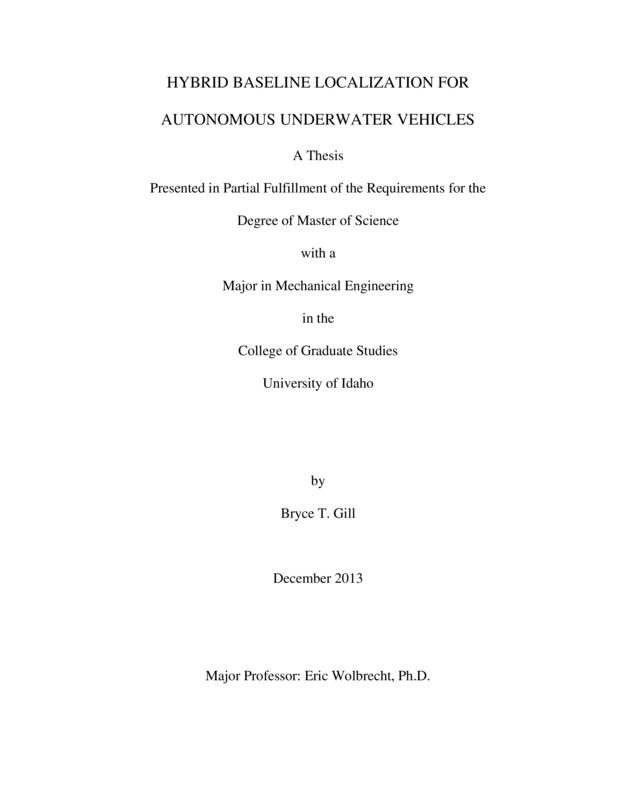Hybrid Baseline Localization for Autonomous Underwater Vehicles
Gill, Bryce Thomas. (2013). Hybrid Baseline Localization for Autonomous Underwater Vehicles. Theses and Dissertations Collection, University of Idaho Library Digital Collections. https://www.lib.uidaho.edu/digital/etd/items/gill_idaho_0089m_10070.html
- Title:
- Hybrid Baseline Localization for Autonomous Underwater Vehicles
- Author:
- Gill, Bryce Thomas
- Date:
- 2013
- Keywords:
- Acoustic Ranging Autonomous Underwater Vehicle Baseline Kalman Filter Navigation State Estimation
- Program:
- Mechanical Engineering
- Subject Category:
- Robotics; Naval engineering
- Abstract:
-
This thesis presents the hybrid baseline (HBL) navigation method for autonomous underwater vehicles (AUVs). This method seeks to improve existing navigation methods used to control a fleet of AUVs that have been developed at the University of Idaho for the purpose of measuring the magnetic disturbance caused by a surface vessel. The acquired magnetic data can be used to model the magnetic signature (i.e. disturbance field) of the vessel, enabling the deployment of magnetic field cancellation techniques to minimize susceptibility to magnetically-triggered sea mines. The accuracy of this magnetic signature model is directly dependent upon the navigational accuracy of the AUVs acquiring the data.
HBL navigation is designed as a hybrid application of independent floating transponders and moving short baseline navigation, in which acoustic ranging transponders are mounted on a moving source vessel. The AUV utilizes an extended Kalman filter (EKF) to estimate its own position, and two additional EKFs to estimate the positions of the objective ship and a nearby floating buoy. Using synchronous timing, the AUV communicates acoustically with the two surface vehicles. These communications provide the AUV with state measurements of the surface vehicles and acoustic range measurements of its own position.
The position of the buoy relative to the AUV-ship waypoint path provides the AUV with perpendicular-to-path range data (in addition to the parallel-to-path data from the ship). A MATLAB-based simulation environment was designed and used to optimize the performance of HBL navigation, and field tests were performed to verify the simulation results and evaluate the accuracy of the navigation method. After the field tests, high-accuracy position and timing data for the objective ship and floating buoy were used to recreate the path of the AUV using an optimized postprocessing EKF. The accuracy of the navigation was determined relative to AUV positions determined by an acoustic tracking array at the test facility. The resulting AUV position estimation showed a mean error of 1.59 m, an improvement over the previous result (using moving short baseline navigation) of 3.30 m.
- Description:
- masters, M.S., Mechanical Engineering -- University of Idaho - College of Graduate Studies, 2013
- Major Professor:
- Wolbrecht, Eric
- Committee:
- Anderson, Michael; Edwards, Dean
- Defense Date:
- 2013
- Identifier:
- Gill_idaho_0089M_10070
- Type:
- Text
- Format Original:
- Format:
- application/pdf
- Rights:
- In Copyright - Educational Use Permitted. For more information, please contact University of Idaho Library Special Collections and Archives Department at libspec@uidaho.edu.
- Standardized Rights:
- http://rightsstatements.org/vocab/InC-EDU/1.0/

